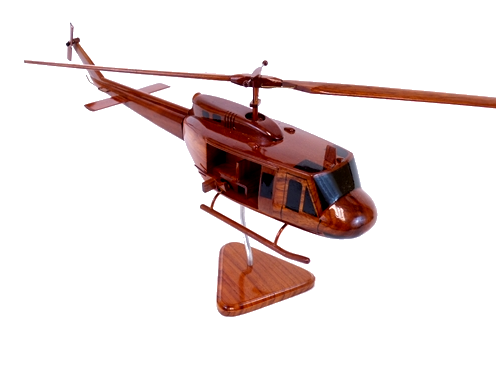

McLean bought the helicopter as surplus for $14,000 three years ago - it had last been used to fight fires in Florida. But, as McLean's family has discussed, a Learjet's just not practical. So far, a man has offered to trade him a Learjet for McLean's piece of military history. Last month, McLean posted the "pinnacle" of his collection on Craigslist for $175,000. "Everyone said, 'Why'd you buy that?'" McLean said. To view, visit Cevon McLean's backyard in Lothian. The blades spin, but the 1965 UH-1E Huey gunship is not flyable. Records missing, but mounts, gun replicas and rocket pods included. The last Air Cavalry Troop departed Vietnam in early 1973.For sale: painstakingly restored Vietnam War-era Marine helicopter. When their parent units departed Vietnam, many of these organic ACT’s continued on under the command of the 1st Aviation Brigade. A representative example of these organic ACT’s was D Troop/3rd Squadron/4th Cavalry (the 3/4 Cav) which served with the 25th Infantry Division. In addition, approximately 20 ACT’s served organically within various infantry, cavalry and mechanized units. The most famous of these was the 1st Squadron/9th Cavalry of the 1st Air Cavalry Division. A total of 5 complete Air Cavalry Squadrons served in Vietnam, 2 within divisions and 3 independently. In addition to this type of mission, ACT’s performed bomb damage assessments (BDA’s), trail recons and whatever other reconnaissance was required for a particular operation.Īir Cavalry Troops and Squadrons performed these reconnaissance missions throughout the war, from their initial deployment in 1965 with the 1st Air Cavalry Division through their later assignment to other Army units. As the contact developed, larger units would be combat assaulted into the operation. After this was completed, the ACT’s slicks provided immediate support to that platoon, much as an Assault Helicopter Company provided support to a ground unit during a combat assault operation. Once initial contact was made with the enemy, the ACT would exploit this contact by combat assaulting its "blue platoon", a platoon of infantry organic to the troop, into battle. In the most common air cavalry mission, an ACT would conduct visual reconnaissance with 1 or 2 scouts and 1 or 2 gunships, called a "pink team". Very late in the war, Bell OH-58’s were also tried in the scout role with limited success. By 1968, these aircraft had largely been replaced by the Hughes OH-6, the best scout helicopter of the war. Initially, these were Bell OH-13’s or Hiller OH-23’s. However, there was also a "scout" platoon of 8-9 Light Observation Helicopters (commonly called "loaches").

TOY HUEY HELICOPTER VIETNAM SERIES
In an Air Cavalry Troop, there was a slick platoon of 6-8 UH-1D/H aircraft and a gun platoon of 8-9 UH-1 series gunships or Cobras, similar to the slick and gun platoons of an AHC. The significant difference between these units was the primary mission performed and an additional type of aircraft utilized by ACT’s to accomplish that mission. An Air Cavalry Troop (ACT) contained roughly the same number of helicopters as an Assault Helicopter Company. An Air Cavalry Squadron usually consisted of three Air Cavalry Troops and a Headquarters Troop.

These units were organized along loosely similar lines to Assault Helicopter Companies and Battalions. In order to better understand the mission of Assault Helicopter Companies and Battalions, it is worthwhile at this point to compare this mission to that of Air Cavalry Troops and Squadrons.


 0 kommentar(er)
0 kommentar(er)
